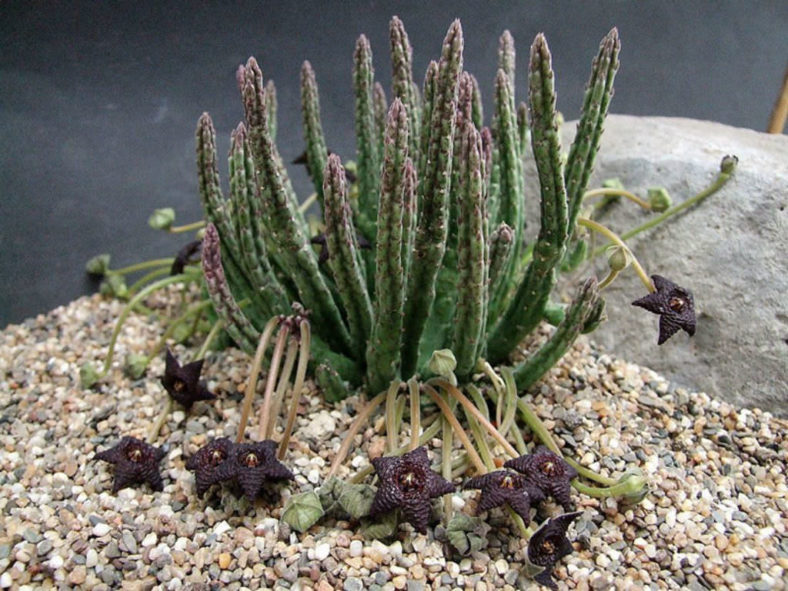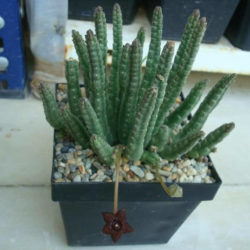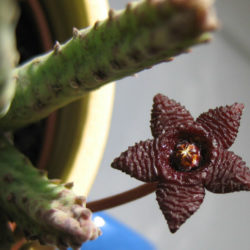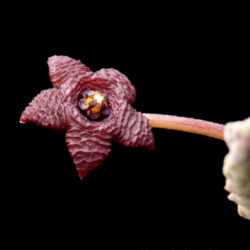Scientific Name
Stapelia similis N.E. Br.
Common Name(s)
Similar Stapelia
Synonym(s)
Ceropegia juttae, Gonostemon similis, Stapelia juttae
Scientific Classification
Family: Apocynaceae
Subfamily: Asclepiadoideae
Tribe: Stapeliae
Genus: Stapelia
Description
Stapelia similis is a small succulent plant that forms dense clumps of slender, erect, shortly pubescent stems with tiny tubercles joined into four angles along the stem with slight grooves between them. The stems are up to 6 inches (15 cm) long and 0.5 inches (1.2 cm) thick. They are pale green, usually with purple in grooves between angles. Each tubercle is tipped with a short-leaved leaf rudiment.
The inflorescences are covered with short soft hairs, usually 1 per stem near the base, each with 1 to 6 flowers opening in gradual succession. The flowers are borne on up to 3.2 inches (8 cm) long stalks that usually spread away from the plant to place the flower facing upwards on the ground. The star-shaped corolla has five pointed lobes, inside densely and coarsely transversely wrinkled, yellow-brown to dark brown or almost black. The little inner corona lobes are pressed close to the anthers and more or less equal to them. The corona is red-brown to black becoming red or yellow towards the base.
Origin
This species is native to Namibia (from southwest of Rehoboth to Witpütz) and South Africa (Richtersveld and eastwards along the Orange River to Upington). It grows on stony slopes or gravelly flats, often under small bushes.

Hardiness
USDA hardiness zone 9a to 11b: from 20 °F (−6.7 °C) to 50 °F (+10 °C).
How to Grow and Care
Several species are fairly easy to grow. Others, often those with slightly hairy stems and the more unusual flowers, are more challenging and require careful watering (with some fertilizer) during the growing season and complete water withdrawal during the winter months. A minimum winter temperature of 10°C (50°F) is acceptable, providing that plants are kept absolutely dry. A heated growing bench or incubator may help delicate plants to get through the colder months. However, many species live under shrubs in their habitat and prefer light shade rather than full sun.
A gritty compost is essential, and clay pots are advisable for the more delicate species. Some growers prefer mineral-only compost to minimize the chance of a fungal attack on the roots. A layer of grit on the surface of the compost prevents moisture from accumulating around the base of the stems.
Keeping Stapelias and their roots free of pests such as mealybugs is the key to success, as fungal attack often occurs due to damage to stems by insects.
See more at How to Grow and Care for Stapelia.
Links
- Back to genus Stapelia
- Succupedia: Browse succulents by Scientific Name, Common Name, Genus, Family, USDA Hardiness Zone, Origin, or cacti by Genus
Photo Gallery
Click on a photo to see a larger version.


